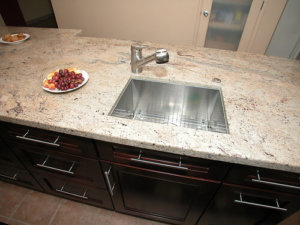How to Install Undermount Kitchen Sinks
Undermount sinks mount underneath the countertop, allowing you to wipe food crumbs directly into the sink. These sinks embrace a minimalist style and increase the aesthetics of your kitchen. If you’re tight on room, these sinks give you extra usable space and the flexibility of positioning your faucets.
Since they are mounted below the countertop, they do not have exposed rims, making them a tad more difficult to install than the traditional drop-in sinks. Undermount sinks can only be installed on solid surfaces made of stone or granite. You cannot install them under ceramic tiles, wood tops, or plastic laminates.
Proper installation of undermount sinks is the key to their longevity and usability. In this article, we’ll guide you through a step-by-step process of installing undermount kitchen sinks.
Deciding on the Type of Undermount Sink

Image via Flickr by NancyHugoCKD.com
The size of the sink will determine the size, shape, and position of the opening cut into which you will install the sink. Make sure to pre-drill holes for faucet and accessory mounts.
Note that countertop suppliers use default OEM’s specifications unless you’ve got a distinct design. Undermount sinks come in various materials, including copper, steel, cast iron, fireclay, and granite. Regardless of the material, you can choose between a single bowl or double bowl sink.
Sink manufacturers and countertop fabricators recommend that you leave the drilling and cutout procedures to professionals. It can be expensive if you chip or crack your countertop inadvertently. So, even if you are an experienced home contractor, without the required tools you cannot make precise cuts and drill perfect holes.
Choose the Reveal Style
A sink reveal is how much the sink is exposed under the countertop. Because health codes in most municipalities require that all surfaces in the food prep area be revealed, a typical sink cutout from an OEM has a reveal.
You can either choose a positive, negative, or flush (zero) reveal. Positive reveal is where a small portion of the sink rim is revealed from the edge of the countertop. This is a popular choice because it is easier to clean.
With a negative reveal style, the counter extends past the sink walls and is suitable for people who want a more streamlined look of their countertop area. However, the overhanging edge of the countertop can chip away with time. It can also present a challenge when cleaning and mold can easily build up under the overhanging edge.
The flush (zero) reveal is where the edges of the countertop are flush with the sink walls. This style provides a professional look and is easier to clean. Since there is no reveal either at the bottom or at the top, the edges of the sink and the countertop are perfectly aligned.
Get Your Tools Ready
Once the cutout and faucet holes are in place, it is time to install your undermount sink. Gather all the tools, materials, and accessories you will need.
Here are the tools and materials that you’ll need:
Tools
- Caulk gun.
- Pencil.
- Cleaning rugs.
- Circular saw.
- Jigsaw.
- Power drill.
Materials
- Solvents for cleaning the surface, like denatured alcohol.
- Silicone sealant.
- Epoxy.
- Sanding sponge.
- Mounting brackets.
- Caulk.
You don’t need a circular saw, jigsaw, or power drill if you have already made the required cutout and faucet holes.
Installing Your Undermount Sink
Below is a list of steps to take to properly install your undermount sink.
Step 1: Prepare the Surface and Make a Cutout
- Choose the location of where you want to place the sink.
- Measure the area that the sink will fit into by turning the sink upside down and tracing the outline directly on the countertop.
- Make a second outline for the hole, about a half-inch smaller than the original outline.
- Use a circular saw or the jigsaw to make a cutout.
- Use the power drill to make additional holes for faucets and accessories.
Caution: Consider leaving this step for a professional as it not only requires heavy-duty tools, but it can be expensive if you crack or chip your countertop.
Step 2: Underside Installation
Basically, you can install your sink from the underside or decide to flip over the countertop. This technique is common when replacing a delaminated sink or re-installing a sink. Follow these steps when you want to install undermount sinks from below.
- Use a rag and denatured alcohol to clean the inside edges of the cutout.
- Set the sink over the hole and align it to achieve the desired reveal, and trace around the area to mark places where silicone adhesive will be applied.
- Layout the positions of the sink clips at each corner of the sink and at the sides at 10-inch intervals.
- Adhere the sink studs using epoxy and allow it to cure for at least 24 hours.
- Apply silicone around the edges of the cutout.
- Set the sink to correct position per the reveal style, ensuring that the rim is set equally at all sides.
- Slip the sink-clip brackets onto the epoxied studs and tighten the clips, alternating to avoid the sink from shifting to one direction.
- Clean the silicone squeeze-out and wipe the cutout edges using the denatured alcohol.
- Mount faucets and accessory dispensers.
- Join the faucet tubes to the main water supply line.
Step 3: Right-Side Up Installation
This installation process involves installing the sink before attaching the countertop to the base cabinets. You might need a pair of hands to help you through this installation process.
- Allow clearance on all sides of the sink.
- Flip over the countertop so that it is facing upside down.
- Position the sink at the center of the cutout and trace an outline.
- Set the mounting clips at the corners and at the sides at 10-inch intervals.
- Use the right adhesive to glue the clips to the studs in place and allow them to dry up.
- Along the inner edge of the outline, use a caulk gun to apply silicone caulk.
- Position the sink right-side up.
- Clip the sink to the countertop by twisting the wingnuts. Ensure the clips are just finger-tight to prevent putting a strain on the countertop.
- Clean the excess caulk using a rag and denatured alcohol.
- Allow the caulk to dry for 24 hours.
- Turn the countertop over and set it in place.
- Attach faucets, accessories, and garbage disposal if needed.
- Connect the faucet tubes to the water supply lines.
While you can install an undermount sink from home, without the right tools and experience, the process can be messy and expensive. Consider hiring professional undermount sink installers to make the process less stressful and perfect. Allied Plumbing & Heating Supply Co. is just a phone call away when you need emergency or regular undermount sink installation services.


